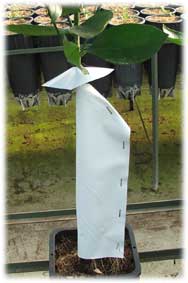|
MULTIPLE ROOTSTOCKS
The practice of grafting additional rootstocks to a tree is called
inarching and was developed hundreds of years
ago to give plants longevity. Its commercial
utilization in large scale was pioneered by Brazilian citrus growers
to prevent tree losses caused by the disease Citrus Sudden Death.
Citrolima nursery trees now have 2 rootstocks as a standard. The
objective is to maintain the excellent qualities of our most common
rootstock, Rangpur lime ( broad soil adaptability, rapid initial
development, drought resistance, early bearing and high
productivity), combined with disease resistance (foot rot,
nematodes, blight, sudden death) of another rootstock like Swingle
citrumelo. Inarching of additional rootstocks is utilized in some
areas of the world to attain more vigorous and long living fruit
trees. Citrus trees with 2 rootstocks survive Citrus Sudden Death
even on the susceptible rootstock Rangpur lime. There are orange
trees over 100 years old that lived through foot rot and who knows
what else by the use of the multiple rootstocks technique. The best
timing for adding a second rootstock is during the nursery tree
stage. Costs are lower and successful rates higher. Citrolima
developed special techniques that allow for the addition of a second
rootstock to its citrus nursery trees efficiently and economically. patent requested  TRUNK PROTECTORS The objective is to prevent trunk sprouting and to protect the young tree trunk against chemical injury from herbicides or fertilizers, and rodent attacks. These protectors come with our class A citrus plants and are easily applied in the field. They are made of UV resistant plastic which is black on the inside, to prevent light from stimulating trunk sprouting, and white on the outside to reduce heating in the area. The grower saves with almost elimination of sprouting operations, less chemical damage, and profits with more vigorous and uniform tree growth. In addition, leaf cutting ant damage is also reduced. |